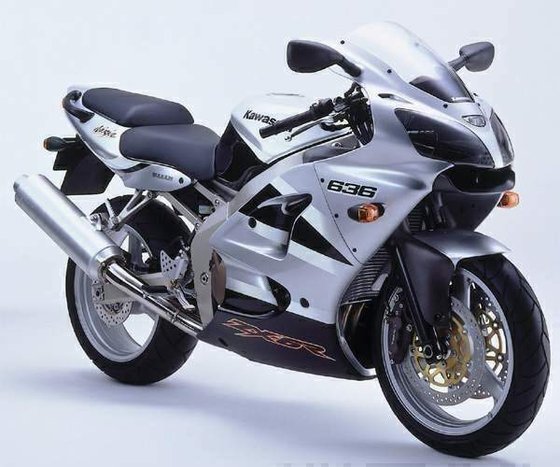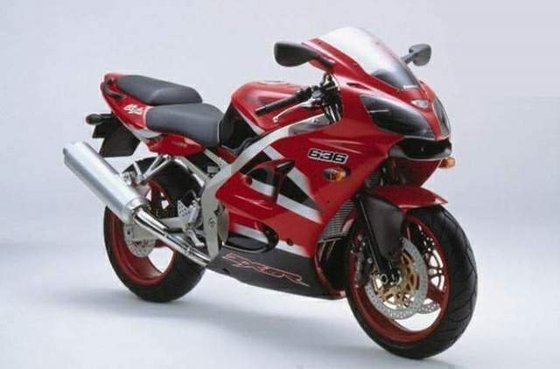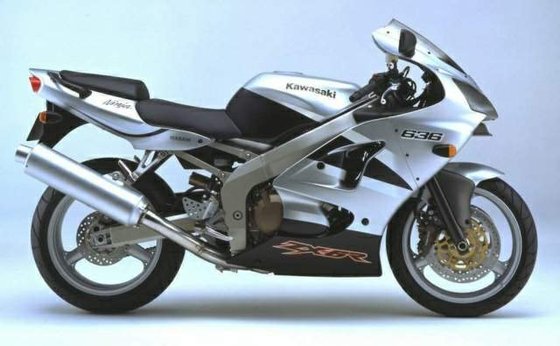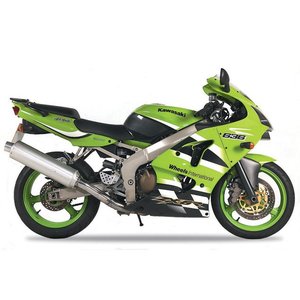Kawasaki ZX-6R Ninja 636 (2002): The 636cc Middleweight That Rewrote the Rulebook

Introduction
The 2002 Kawasaki ZX-6R Ninja 636 remains one of the most fascinating experiments in sportbike history - a bold middle finger to racing homologation rules that gave riders something truly special. By pushing displacement to 636cc in a 600cc-dominated market, Kawasaki created a street-oriented supersport machine with torque-rich character that still makes modern riders look twice. After throwing a leg over this iconic green machine, it's clear why this single-year model developed cult status among sportbike enthusiasts.
Design & Ergonomics: Aggressive Looks Meet Street Pragmatism

Kawasaki's design team pulled no punches with the 636's aesthetics. The sharp, angular bodywork borrows heavily from its larger ZX-9R sibling, featuring a dual-headlight front fairing that looks like it could slice through air molecules individually. While the 715mm width (28.1") makes it appear bulky in photos, the actual riding position reveals clever packaging - the 820mm seat height (32.3") remains accessible for shorter riders while maintaining proper sportbike crouch.
The magnesium engine covers and aluminum frame keep dry weight down to 174kg (383 lbs), though the 18L fuel tank adds noticeable mass when topped up. Practical touches include: - LED taillight (revolutionary for 2002) - Aerodynamic inner rear fender - Tool-free adjustable clutch lever - Center-mounted analog tach with digital speedo flank
The real magic happens at speed - Kawasaki's wind tunnel work pays dividends with clean airflow around the rider's helmet at triple-digit velocities. Vibrations through the clip-ons remain surprisingly muted given the high-strung inline-four beneath.
Engine & Performance: The 636cc Advantage

Let's address the elephant in the room - that glorious 636cc inline-four. By boring out the previous 599cc motor to 68mm pistons (2.68") while keeping the 43.8mm stroke (1.72"), Kawasaki engineers struck gold between 600cc agility and 750cc grunt.
The numbers tell part of the story: - 118 HP @ 12,500 RPM (86 kW) - 50.7 lb-ft torque @ 12,000 RPM (68.8 Nm) - 12.8:1 compression ratio - 11.0-second quarter mile @ 127 mph (203 km/h)
But the seat-of-pants experience reveals why this motor became legendary. Unlike peaky 600s that go from docile to demonic above 10k RPM, the 636 delivers: - Usable power from 5,000 RPM - A violent surge at 8,000 RPM that pins shoulders to the tank - Overrev capability to 14,000 RPM (despite the 12,500 RPM power peak)
The Mikuni BDSR36R carburetors - equipped with throttle position sensors for smoother transitions - pair beautifully with the 4-2-1 exhaust. Cold starts require patience (that 1050 RPM idle needs precise choke management), but once warm, the motor responds with telepathic throttle connection missing from modern ride-by-wire systems.
Handling: A Dance Between Stability and Agility
Kawasaki's aluminum twin-spar frame (1400mm/54.7" wheelbase) walks a fine line between track-ready stiffness and street compliance. The 24.5° rake and 95mm trail (3.7") suggest stable geometry, but the forward weight bias (achieved through swingarm pivot positioning) gives the 636 surprising flickability.
Suspension highlights include: - 46mm cartridge forks (119mm/4.7" travel) with 12-way compression/rebound - Bottom-Link Uni-Trak rear shock (132mm/5.2" travel) - Threaded ride height adjustment - Piggyback reservoir for consistent damping
At pace, the setup feels firm but communicative - you'll feel every pavement ripple through the seat, but never get overwhelmed by mid-corner bumps. Dialing in the suspension requires patience (the 18-way rear compression adjuster needs careful tuning), but rewards with track-day competence.
Braking: Tokico's Masterclass in Modulation
The 636's braking system remains a benchmark for organic feel:
- Dual 300mm floating rotors (5mm thick)
- Radial-mount Tokico 6-piston calipers (24mm+2x27mm pistons)
- 220mm rear rotor with ZX-9R-spec caliper
Initial bite borders on aggressive, but progression remains linear even when trail-braking into corners. Kawasaki's choice of DOT 4 fluid (replace every 2 years) prevents fade during repeated hard stops from 160+ km/h (100+ mph).
Competition: The 636cc Disruptor
In 2002, the middleweight sportbike wars were fought with 599cc weapons: - Honda CBR600F4i: Smoother powerband, better ergonomics - Yamaha YZF-R6: Higher-revving, sharper handling - Suzuki GSX-R600: Lighter weight, race-focused
The Ninja 636 carved its niche through: 1. Street Dominance: 15% more torque below 8,000 RPM vs competitors 2. Real-World Usability: No need to wring the motor to redline 3. Customization Potential: Tuners could extract 130+ HP with simple mods
On backroads, the Kawasaki's power advantage let riders short-shift while keeping pace with screaming 600s. At the drag strip, its 11.0-second quarter mile trounced rivals by 0.3-0.5 seconds. Only on tight circuits did the extra 37cc become a liability, with higher weight (199kg wet vs 192kg GSX-R) affecting direction changes.
Maintenance: Keeping the 636 in Fighting Trim
As MOTOPARTS.store specialists, we recommend these key maintenance items:
1. Valve Adjustments
- Intake: 0.11-0.19mm (0.004-0.007")
- Exhaust: 0.22-0.31mm (0.008-0.012")
Use feeler gauges with angled tips for the rear cylinders
2. Oil Changes
- 3.6L with filter (SAE 10W-40)
- Replace crush washer every 3 changes
3. Carb Tuning
- Stock setting: 2.25 air screw turns out
- For altitude changes: Adjust pilot jets
4. Chain Maintenance
- 108-link DID 525 chain
- 15/40 sprocket combo wears faster than 15/42
5. Cooling System
- 2.3L coolant capacity
- Bleed air from upper radiator hose
6. Spark Plugs
- NGK CR9E (standard)
- CR9EIX iridium for colder climates
MOTOPARTS.store Recommendations:
- K&N KA-6362 Oil Filter
- EBC Double-H Sintered Brake Pads
- DID 525VX3 X-Ring Chain Kit
- NGK Iridium IX Spark Plug Set
Conclusion: The Middleweight That Changed the Game
Twenty years haven't dulled the Ninja 636's appeal. That intoxicating blend of mid-range punch, stable chassis, and radical styling continues to attract riders tired of peaky 600s. While later models adopted fuel injection and rider modes, this carbureted warrior reminds us of sportbiking's analog glory days - raw, demanding, and endlessly rewarding.
For current owners, MOTOPARTS.store carries everything needed to keep your 636 running stronger than Kawasaki engineers imagined. From performance chains to race-spec brake pads, we've got your back through every rev-limited mile.
Specifications sheet
| Engine | |
|---|---|
| Stroke: | Four-stroke |
| Ignition: | Digital |
| Max power: | 86 kW | 115.0 hp |
| Max torque: | 68 Nm |
| Fuel system: | 4 x Mikuni BDSR36R carburetors |
| Lubrication: | Wet sump |
| Max power @: | 12500 rpm |
| Spark plugs: | NGK CR9E or NGK CR9EIX |
| Displacement: | 636 ccm |
| Max torque @: | 12000 rpm |
| Bore x Stroke: | 68 x 43.8 mm |
| Configuration: | Inline |
| Cooling system: | Liquid-cooled |
| Spark plug gap: | 0.8 |
| Compression ratio: | 12.8:1 |
| Number of cylinders: | 4 |
| Dimensions | |
|---|---|
| Wheelbase: | 1400 mm (54.7 in) |
| Dry weight: | 174 |
| Wet weight: | 199 |
| Seat height: | 820 mm (32.3 in) |
| Overall width: | 715 mm (28.1 in) |
| Overall height: | 1110 mm (43.7 in) |
| Overall length: | 2065 mm (81.3 in) |
| Ground clearance: | 145 mm (5.7 in) |
| Fuel tank capacity: | 18 L (4.8 US gal) |
| Drivetrain | |
|---|---|
| Clutch: | Wet, multiple discs, cable-operated |
| Final drive: | chain |
| Chain length: | 108 |
| Transmission: | 6-speed |
| Rear sprocket: | 40 |
| Front sprocket: | 15 |
| Maintenance | |
|---|---|
| Rear tire: | 180/55 z-17 |
| Engine oil: | 10W40 |
| Front tire: | 120/65 z-17 |
| Brake fluid: | DOT 4 |
| Coolant capacity: | 2.3 |
| Forks oil capacity: | 0.914 |
| Engine oil capacity: | 3.6 |
| Engine oil change interval: | Every 5000 km or 2 years |
| Valve clearance (intake, cold): | 0.11–0.19 mm |
| Valve clearance (exhaust, cold): | 0.22–0.31 mm |
| Recommended tire pressure (rear): | 2.9 bar (42 psi) |
| Recommended tire pressure (front): | 2.5 bar (36 psi) |
| Additional Notes | |
|---|---|
| Idle speed: | 1050 ± 50 rpm |
| Exhaust system: | 4-2-1 stainless steel with aluminum muffler |
| Carburetor adjustment: | Throttle position sensor equipped |
| Front brake pad design: | Individual pads per piston for heat distribution |
| Chassis and Suspension | |
|---|---|
| Rake: | 24.5° |
| Frame: | Aluminum twin-spar |
| Trail: | 95 mm (3.7 in) |
| Rear brakes: | Single 220 mm disc, 1-piston caliper |
| Front brakes: | 2 x 300 mm discs, 4-piston calipers |
| Rear suspension: | Bottom-Link Uni-Trak with piggyback shock, 18-way rebound/20-way compression damping, preload adjustable |
| Front suspension: | 46 mm cartridge fork, 12-way rebound/compression damping, preload adjustable |
| Rear wheel travel: | 132 mm (5.2 in) |
| Front wheel travel: | 119 mm (4.7 in) |



















